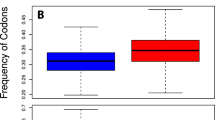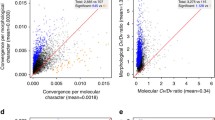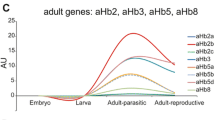Summary
The evolutionary relation of vertebrate myoglobin and the hemoglobin chains including the agnathan hemoglobin chain is investigated on the basis of a new view of amino acid changes that is developed by canonical discriminant analysis of amino acid residues at individual sites. In contrast to the clear discrimination of amino acid residues between myoglobin, hemoglobin a chain, and hemoglobin β chain in warm-blood vertebrates, the three types of globins in the lower class of vertebrates show so much variation that they are not well discriminated. This is seen particularly at the sites that are ascertained in mammals to carry the amino acid residues participating in stabilizing the monomeric structure in myoglobin and the residues forming the subunit contacts in hemoglobin. At these sites, agnathan hemoglobin chains are evaluated to be intermediate between the myoglobin and hemoglobin chains of gnathostomes. The variation in the phylogenetically lower class of globins is also seen in the internal region; there the amino acid residues of myoglobin and hemoglobin chains in the phylogenetically higher class exhibit an example of parallel evolution at the molecular level. New quantities, the distance of sequence property between discriminated groups and the variation within each group, are derived from the values of discriminant functions along the peptide chain, and this set of quantities simply describes an overall feature of globins such that the distinction between the three types of globins has been clearer as the vertebrates have evolved to become jawed, landed, and warm-blooded. This result strongly suggests that the functional constraint on the amino acid sequence of a protein is changed by living conditions and that severe conditions constitute a driving force that creates a distinctive protein from a less-constrained protein.
Similar content being viewed by others
References
Arata Y, Otsuka J (1975) Calculation of the energy difference between the quaternary structures of deoxy- and oxyhemoglobin. Biochim Biophys Acta 405:388–403
Ayala FJ (1974) Biological evolution: natural selection or random walk? Am Sci 62:692–710
Baldwin J, Chothia C (1979) Haemoglobin: the structural changes related to ligand binding and its allosteric mechanism. J Mol Biol 129:175–220
Baldwin TO, Riggs A (1974) The hemoglobins of the bullfrog,Rana catesbeiana. Partial amino acid sequence of the β chain of the major adult component. J Biol Chem 249:6110–6118
Barker R (1971) Organic chemistry of biological compounds. Prentice-Hall, Englewood Cliffs, NJ
Bossa F, Barra D, Coletta M, Martini F, Liverzani A, Petruzzelli R, Bonaventura J, Brunori M (1976) Primary structure of hemoglobins from trout (Salmo irideus). Partial determination of amino acid sequence of Hb trout IV. FEBS Lett 64: 76–80
Bossa F, Barra D, Petruzzelli R, Martini F, Brunori M (1978) Primary structure of hemoglobin from trout (Salmo irideus). Amino acid sequence of α chain of Hb trout I. Biochim Biophys Acta 536:298–305
Briehl RW (1963) The relation between the oxygen equilibrium and aggregation of subunits in lamprey hemoglobin. J Biol Chem 138:2361–2366
Brittain T, O'Brien AJ, Wells RMG, Baldwin J (1989) A study of the role of subunit aggregation in the expression of cooperative ligand binding in the haemoglobin of the lampreyMorodacia mordax. Comp Biochem Physiol 93B:549–554
Chauvet JP, Acher R (1972) Phylogeny of hemoglobins. β chain of frog (Rana esculenta) hemoglobin. Biochemistry 11:916–927
Czelusniak J, Goodman M, Hewett-Emmett D, Weiss ML, Venta PJ, Tashian RE (1982) Phylogenetic origins and adaptive evolution of avian and mammalian haemoglobin genes. Nature 298:297–300
D'Avino R, Caruso C, Romano M, Camardella L, Rutigliano B, Di Prisco G (1989) Hemoglobin from the antarctic fishNotothenia corfceps neglecta. 2. Amino acid sequence of the α chain of Hb 1. Eur J Biochem 179:707–713
Dayhoff MO (ed) (1969) Atlas of protein sequence and structure, vol 4. National Biomed Res Found, Silver Spring, MD
Dickerson RE (1971) The structure of cytochrome c and the rates of molecular evolution. J Mol Evol 1:26–45
Dickerson RE, Geis I (1983) Hemoglobin: structure, function, evolution and pathology. Benjamin, Menlo Park, NY
Fisher RA (1936) The use of multiple measurements in taxonomic problems. Ann Eugen 7:179–188
Fitch WM, Margoliash E (1967) Construction of phylogenetic trees. Science 155:279–284
Friend SH, Gurd FRN (1979) Electrostatic stabilization in myoglobin. Interaction free energies between individual sites. Biochemistry 18:4620–4630
Gillespie JH (1984) The molecular clock may be an episodic clock. Proc Natl Acad Sci USA 81:8009–8013
Goodman M (1981) Globin evolution was apparently very rapid in early vertebrates: a reasonable case against the rate-constancy hypothesis. J Mol Evol 17:114–120
Goodman M, Moore GW, Matsuda G (1975) Darwinian evolution in the genealogy of haemoglobin. Nature 253:603–608
Goodman M, Czelusniak J, Koop BF, Tagle DA, Slightom JL (1987) Globins: a case study in molecular phylogeny. Cold Spring Harbor Symp Quant Biol 52:875–890
Grantham R (1974) Amino acid difference formula to help explain protein evolution. Science 185:862–864
Grujic-Injac B, Braunitzer G, Stangi A (1980) Hemoglobins, XXXV: the sequence of the βA and βB-chains of the hemoglobins of the carp (Cyprinus carpio L.). Hoppe-Seyler's Z Physiol Chem 361:1629–1639
Harris H (1976) Molecular evolution: the neutralist-selectionist controversy. Fed Proc 35:2079–2082
Horimoto K, Suzuki H, Otsuka J (1990) Discrimination between adaptive and neutral amino acid substitutions in vertebrate hemoglobins. J Mol Evol 31:302–324
Huber F, Braunitzer G (1989) The primary structure of the hemoglobin of the electric eel (Electrophorus electricus). Biol Chem Hoppe-Seyler 370:245–250
Ingram VM (1963) The hemoglobins in genetics and evolution. Columbia University Press, New York
Jeffreys AJ (1982) Evolution of globin genes. In: Dover GA, Falvell RB (eds) Genome evolution. Academic Press, London, p 157
Kendrew JC, Dickerson RE, Strandberg BE, Hart RG, Davies DR, Phillips DC, Shore VC (1960) Structure of myoglobin. A three-dimensional Fourier synthesis at 2 Å resolution. Nature 185:422–427
Kimura M (1968) Evolutionary rate at the molecular level. Nature 217:624–626
Kimura M (1969) The rate of molecular evolution considered from the standpoint of population genetics. Proc Natl Acad Sci USA 63:1181–1188
Kimura M (1981a) Was globin evolution very rapid in its early stages?: A dubious case against the rate-constancy hypothesis. J Mol Evol 17:110–113
Kimura M (1981b) Doubt about studies of globin evolution based on maximum parsimony codons and the augmentation procedure. J Mol Evol 17:121–122
King JL, Jukes TH (1969) Non-Darwinian evolution. Science 164:788–789
Lachenbruch PA (1975) Discriminant analysis. Hafner Press, New York
Ladner RC, Heidner EJ, Perutz MF (1977) The structure of horse methaemoglobin at 2.0 Å resolution. J Mol Biol 114: 385–414
Li SL, Riggs A (1970) The amino acid sequence of hemoglobin V from the lamprey,Petromyzon marinus. J Biol Chem 245: 6149–6169
Lipman DJ, Pearson WR (1985) Rapid and sensitive protein similarity searches. Science 227:1435–1441
Margoliash E (1963) Primary structure and evolution of cytochrome c. Proc Natl Acad Sci USA 50:672–679
Moore GW, Barnabas J, Goodman M (1973) A method for constructing maximum parsimony ancestral amino acid sequences on a given network. J Theor Biol 38:459–485
Nozaki Y, Tanford C (1971) The solubility of amino acids and two glycine peptides in aqueous ethanol and dioxane solutions. J Biol Chem 246:2211–2217
Ohno S (1970) Evolution by gene duplication. Springer-Verlag, Berlin
Perutz MF, Rossmann MG, Cullis AF, Muirhead H, Will G, North ACT (1960) Structure of haemoglobin. A three-dimensional Fourier synthesis at 5.5-Å resolution, obtained by X-ray analysis. Nature 185:416–422
Perutz MF, Kendrew JC, Watson HC (1965) Structure and function of haemoglobin. II. Some relations between polypeptide chain configuration and amino acid sequence. J Mol Biol 13: 669–678
Perutz MF, Brunori M (1982) Stereochemistry of cooperative effects in fish and amphibian haemoglobins. Nature 299:421–426
Riggs A (1970) Properties of fish hemoglobins. In: Hoar WS, Randall DJ (eds) Fish physiology. Academic Press, New York, vol 4, p 209
Romero-Herrera AE, Lehmann H, Joysey KA, Friday AE (1978) On the evolution of myoglobin. Phil Trans Roy Soc London (B) 283:61–163
Takahata N (1987) On the overdispersed molecular clock. Genetics 116:169–179
Tentori L, Vivaldi G, Carta S, Velani S, Zito R (1967) The hemoglobin of amphibia V amino terminal residues and the carboxyl-terminal sequences of the hemoglobin ofRana esculenta. Biochim Biophys Acta 133:177–180
Watts DA, Rice RH, Brown WD (1980) The primary structure of myoglobin from yellowfin tuna. J Biol Chem 255:10916–10924
Wilbur WJ, Lipman DJ (1983) Rapid similarity searches of nucleic acid and protein data banks. Proc Natl Acad Sci USA 80:726–730
Young JZ (1962) The life of vertebrates, ed 2. Oxford University Press, New York
Zuckerkandl E, Pauling L (1962) Molecular disease, evolution, and genetic heterogeneity. In: Kasha M, Pullman B (eds) Horizons in biochemistry. Academic Press, New York, p 189
Zuckerkandl E, Pauling L (1965) Evolutionary divergence and convergence in proteins. In: Bryson V, Vogel HJ (eds) Evolving genes and proteins. Academic Press, New York, p 97
Author information
Authors and Affiliations
Additional information
Offprint requests to: J. Otsuka
Rights and permissions
About this article
Cite this article
Otsuka, J., Miyazaki, K. & Horimoto, K. Divergence pattern and selective mode in protein evolution: The example of vertebrate myoglobins and hemoglobin chains. J Mol Evol 36, 153–181 (1993). https://doi.org/10.1007/BF00166251
Received:
Revised:
Accepted:
Issue Date:
DOI: https://doi.org/10.1007/BF00166251




